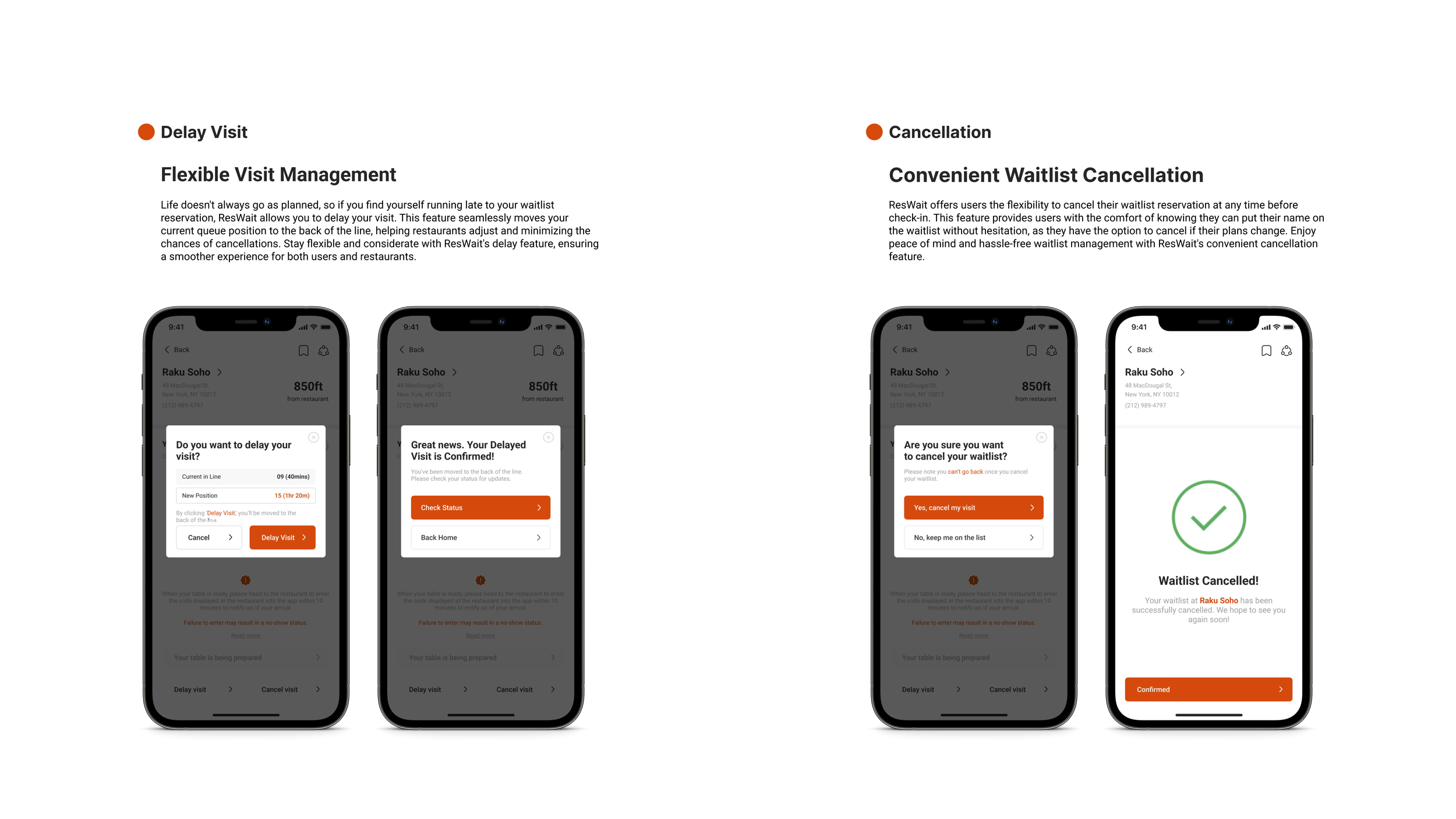Reswait.
Unlocking Seamless Dining with Waitlist and Reservation Features
Project type: End-to-end app + branding.
Role: Sole UX/UI designer + brand designer
Industry: Hospitality - restaurant and dining sector
Tools: Figma, FigJam, Illustrator
Duration: Jan 2024 - Mar 2024
High-Fidelity Prototype
Overview
In this exhilarating project, we embarked on a journey to revolutionize the dining experience with ResWait, a groundbreaking app designed to elevate every aspect of restaurant reservations and waitlist management. Our mission was clear: to craft an intuitive and user-centric interface that puts the power of dining in the hands of our users. With meticulous attention to detail, we honed ResWait to be more than just a tool – it's a culinary companion, seamlessly integrating into the fabric of modern dining culture.
At ResWait, we understand the diverse needs of diners and restaurant staff alike. That's why we've meticulously engineered every feature to cater to a wide range of dining scenarios. Whether you're a food enthusiast eager to explore nearby culinary gems or a restaurant owner seeking to optimize table turnover, ResWait has you covered. By blending cutting-edge technology with intuitive design, ResWait transforms the dining landscape, offering a new standard of convenience and enjoyment. Join us on this gastronomic adventure and discover a world where every meal is an unforgettable experience.
Users often face uncertainty about wait times when visiting restaurants, leading to frustration and inconvenience.
Crowded lobbies create an unpleasant waiting experience for users, making it challenging to relax or plan ahead.
Difficulty in securing reservations in advance hinders users from planning their dining experiences efficiently, resulting in missed opportunities.
Problems
Introduce real-time updates on wait times, allowing users to check waitlist status remotely before heading to the restaurant.
Enable users to join restaurant waitlists remotely via the app, minimizing time spent in crowded lobbies and providing a more convenient waiting experience.
Implement a user-friendly reservation system within the app, enabling users to book tables in advance with ease and convenience, ensuring a smoother dining experience.
Proposed Solutions
Restaurants frequently prioritize reservations, overlooking the needs of users seeking spontaneous dining experiences
Research
In conducting comprehensive research for ResWait, we delved into the dining habits and preferences of users across various demographics. Our aim was to gain insights into the challenges faced by diners when it comes to restaurant waitlists and reservations. Through surveys, interviews, and market analysis, we sought to understand the pain points and desires of users in order to inform the development of ResWait and ensure it meets their needs effectively
Findings
Lack of Transparency: Many users expressed frustration over the lack of transparency in waitlist management at restaurants, with a significant number reporting uncertainty about wait times and the availability of tables.
Inconvenient Waiting Experiences: Crowded lobbies and long wait times were common complaints among diners, highlighting the need for a more streamlined and efficient waitlist system.
Desire for Flexibility: Users expressed a desire for flexibility in making reservations, with many preferring the option to join waitlists remotely and receive real-time updates on table availability.
Importance of Accessibility: Accessibility features such as wheelchair access and dietary preferences emerged as important considerations for users when choosing restaurants, underscoring the need for ResWait to cater to diverse needs and preferences.
Getting Closer to User-Centered Design
Differentiating Key Objectives Across Personas
Through in-depth exploration of user journey maps for two personas tailored to ResWait, I pinpointed pivotal emotional and procedural moments. For example, the frustration of uncertain wait times and the inconvenience of crowded waiting areas. To foster user engagement, the app must address these pain points while maintaining simplicity and ease of use.
Understanding the user perspective, I created the personas to help us move forward with our decision-making.
Exploring Common Tasks in Order to Heighten User Empathy
By examining the journey maps of two personas crafted for ResWait, I pinpointed significant emotional and procedural stages. For example, the frustration of uncertain wait times and the inconvenience of crowded waiting areas. Utilizing user journey maps and flow diagrams aids in understanding user needs and refining the app's design to enhance user experience. This process ensures that ResWait effectively addresses these pain points while maintaining simplicity and usability
Identifying Points of Confusion through Wireframe Prototypes
Low-fidelity prototype testing allowed me to better understand how users expected to complete the tasks I was focusing on. By studying their touch and swipe gestures — and more importantly, having a dialogue with them about what they expected and when — I knew which adjustments needed to be made to lay the foundation for a more fully realized high fidelity prototype. Small details such as actionable and consistent iconography, and consistent paths to get back, would become important elements of the design system.
Enhancing Usability for Better User Experience:
Issues to Address for Longer-Term Development
Conduct comprehensive research with restaurant owners and users to identify key pain points and enhancement opportunities for ResWait's usability.
Implement a dynamic point-based system to incentivize user engagement, fostering loyalty and continued interaction with the platform.
Utilize advanced machine learning algorithms to deliver personalized experiences based on users' dining preferences, past interactions, and location data.
Integrate a streamlined ordering ahead feature to empower users to proactively manage their dining experiences, reducing wait times and enhancing overall convenience.
Introduce a seamless pay feature, allowing users to conveniently settle their bills and provide tips directly within the app, enhancing overall transaction efficiency and user satisfaction.
Lesson Learned
Prioritize inclusivity by implementing features such as screen reader compatibility and keyboard navigation.
Conduct thorough testing with diverse user groups to identify usability issues and barriers to access.
Provide clear and concise instructions within the app to guide users through accessibility features.
Continuously gather feedback from users and iterate on accessibility features based on their input.
Collaborate with accessibility experts or organizations to ensure compliance with relevant guidelines and standards.











